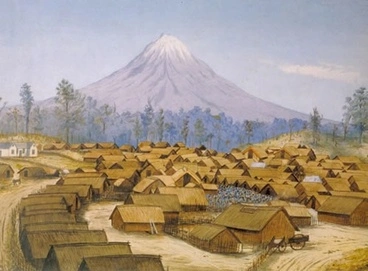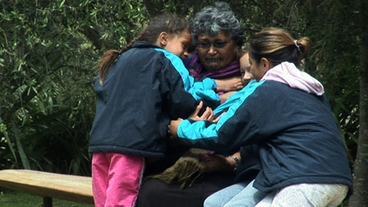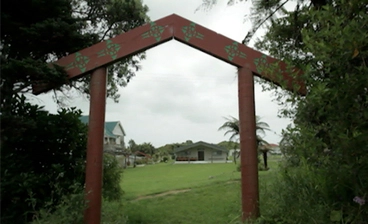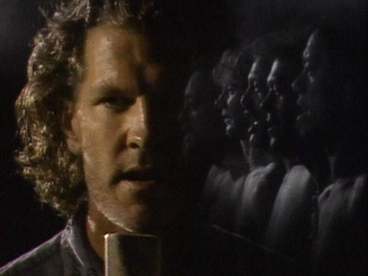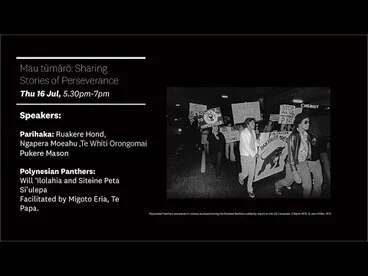Remembering Te Pāhuatanga o Parihaka
A DigitalNZ Story by Wellington City Libraries
There are now so many online resources linking the stories of Parihaka, Te Whiti o Rongomai and Tohu Kākahi – laying out their foundation kaupapa of peaceful resistance. Learn more about Parihaka below.
NZHistory.net.nz Biography of Tohu Kākahi
Manatū Taonga, the Ministry for Culture and Heritage
Painting of Parihaka by George Clarendon Beale (1856–1939)
This is where it all ended in deep commitment to protest, and a determination to retain their land
Manatū Taonga, the Ministry for Culture and Heritage
Here is a trailer of a full documentary recording the journey of Tātarakihi : children of Parihaka tracing the footprint
Tātarakihi - The Children of Parihaka
NZ On Screen
And here are some videos of twentieth and twenty-first century Parihaka kaumātua Lindsay Rihari Waitara Macleod talking about growing up, living and returning back to Parihaka:
Documentary
Te reo series Whare Taonga visits Parihaka. Features Ruakere Hond, Mahara Okeroa
NZ On Screen
Parihaka music video / Tim Finn (1989)
Here is Tim Finn’s very evocative music video explaining the story of Parihaka
NZ On Screen
Return of the ploughman prisoners, Parihaka
Alexander Turnbull Library
Below are some images of Parihaka from the Hocken Library's collection:
Parihaka
Hocken Collections - Uare Taoka o Hākena, University of Otago
At home, Parihaka, woman scraping potatoes with shell
Hocken Collections - Uare Taoka o Hākena, University of Otago
Te Whiti's house, Parihaka
Hocken Collections - Uare Taoka o Hākena, University of Otago
Parihaka
Hocken Collections - Uare Taoka o Hākena, University of Otago
Maori at home, Parihaka
Hocken Collections - Uare Taoka o Hākena, University of Otago
The peoples’ stories of Parihaka were not recorded so much on paper (lest the government distort their messages in a negative way). Rather, the news of the day was spread through waiata, accompanied by the beat of drum and poi.
Waiata became the peoples’ library for the kōrero to be passed from generation to generation.
There may be 20 special waiata still remembered today, but in the time of the pahuatanga these numbered closer to 80 compositions.
Women performing a poi dance, Parihaka
Alexander Turnbull Library
At the beginning of the film below Ruakere Hond describes how the many different sides and variations of kōrero of Parihaka were presented (11.50” – 35.28’), telling of the resilience and resistance and where, who, what is Parihaka.
Ruakere speaks of Parihaka as a community led by Tohu and Te Whiti.
The early times of colonisation brought conflict leading to the growing importance of flax and muskets. Te Whiti and Tohu spent time in Wellington then returned to Warea where they instigated the beginnings of economic development. But the Government wanted Taranaki lands and so began to attack peaceful communities.
A community was established at Parihaka: a new dawn, a new year of land and sanctuary for those wishing to escape 21 years of land wars which ended with the taking of 24,000 acres.
Today, Parihaka retains only 50.19 acres and the communal ownership of land has been destroyed.
In the above kōrero, Ruakere Hond gives us three takeaways:
- Parihaka is not a history - it is alive and well today. It has a past, a present and a future.
- Concept of historical trauma permeated their lives. Peace is a very difficult thing to maintain
- We need to tell our own story: the history and background is very complex. In oral history narrative we all have different stories and we need to find ways to present all of these multiple stories.
Mau tūmārō: Sharing Stories of Perseverance (Thu 16 Jul)
Museum of New Zealand Te Papa Tongarewa
Also listen to The legacy of Parihaka: Dr Rachel Buchanan and Mahara Okeroa in conversation (Radio New Zealand, 2018)
Taranaki Poi
'Maori Poi of Taranaki has significance beyond just entertainment value' - a Waka Huia series in three parts:
- Part one (YouTube)
- Part two (YouTube)
- Part three (YouTube)
The first of three parts describing Māori Poi of Taranaki covers themes of whakapapa, mana and karakia (as vehicles for the stories of genealogy history and land loss)
Themes of this video: Parihaka – a revival ; Ruakere: Jamie Tuuta ; Te Miringa Hohaia – Hemi Sundgren.
From Aotea / Turi emerged the Taranaki poi: ancient, and modified -- te poi was a taonga ; there were tima poi ; the poi was a broadcasting technology, a focus on profound statements.
There were different types of poi: each had its purpose expressed in an ancient/traditional basis, as a vehicle for carrying information.
The parts 2 & 3 of the Taranaki Poi describe the special significance of poi in rohe of Ruanui and Whanganui.
Do you know these waiata of significance for hapū of Taranaki, recorded on a CD produced by Te Kotahitanga o Taranaki me Pōneke? (CD is He Kohikohinga o ngā waiata o Taranaki)
- E rere rā: Hakarei / Kupu Whakaaari This waiata was composed by Muaupoko and taken to Parihaka. (Tohu) E Rere Raa - YouTube
- Home - Wellington Tenths Trust (wtt.maori.nz) (see sound bite)
- E ngā iwi o te motu nei / Waiata/Poi / Te Ati Awa / Te Whiti
- Home - Palmerston North Māori Reserve Trust (pnmrt.maori.nz) (see sound bite)
- Piukara Pao Roa; Quite a powerful waiata in the form of multiple verses of a Pao. Uses the same tune as “Ko Aotea”. Composed when Parihaka prisoners were being held and awaiting trial after the Pahua.Te Tangi a Te Piukara - YouTube
- Te Tangi a taku ihu Waiata Mate. Composed by Te Whetu Moeahu and others at Parihaka. kaupapa is a waiata tangi especially used by Te Ati Awa nui tonu. Te Ao Hou ; no. 54, March 1966. P. 23.
- Te Rā o Maehe. Waiata Tawhito / Poi: Said to have been composed byn the prisoners while in Te Waipounamu. Often used as the first waiata on the paepae, to acknowledge the impact of confiscation and the wrongs of the past.
- Te Rā O Maehe, Te Puapua (Radio New Zealand, Stories of Waitara) - YouTube
- Mangumangu taepō / Pakipakia, Akiakina Haka Composed in Toroanui (Parihaka) in response to a speech by Tohu Kākahi delilvered on the 19th. A warning to those selling land in Taranaki
Poi Today:
Kaumatua of today delight in the old waiata and waiata a-ringa.
- Taranaki ki te Tonga Taikura –Taikura Kapa Haka 2021 - YouTube
- Poi E : Patea Maori Club - Poi E (Music Video) HD - YouTube
- Poi for protest, poi for peace, poi for unity | Te Papa. Ngahina Hohaia 2012
Whakawaiwai ana te tū o Taranaki...
